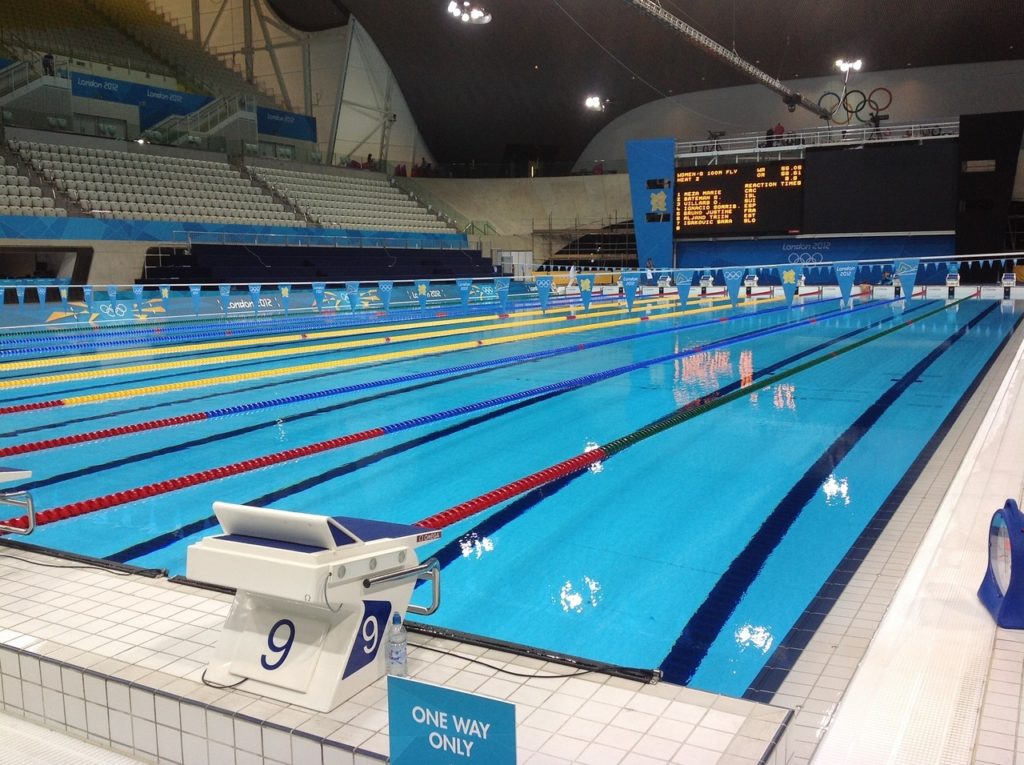In sports, flocks of birds, and schools of fish, we’re accustomed to thinking that the followers get an aerodynamic or hydrodynamic advantage over the leaders, but this may not always be the case. Here are two flags placed one after another in a soap film flowing from top to bottom. The flags are passive, meaning that their motion is entirely dependent on the flow around them; they cannot exert any resistive force of their own. In this case, scientists observe an effect known as inverted drafting. The lead flag actually experiences less drag – by as much as 50% – than the following flag. This seems to be a result of flow around the second flag having an upstream influence on the motion of the first. (Image and research credit: L. Ristroph and J. Zhang, pdf)
Search results for: “drafting”

Sochi 2014: Downhill Skiing
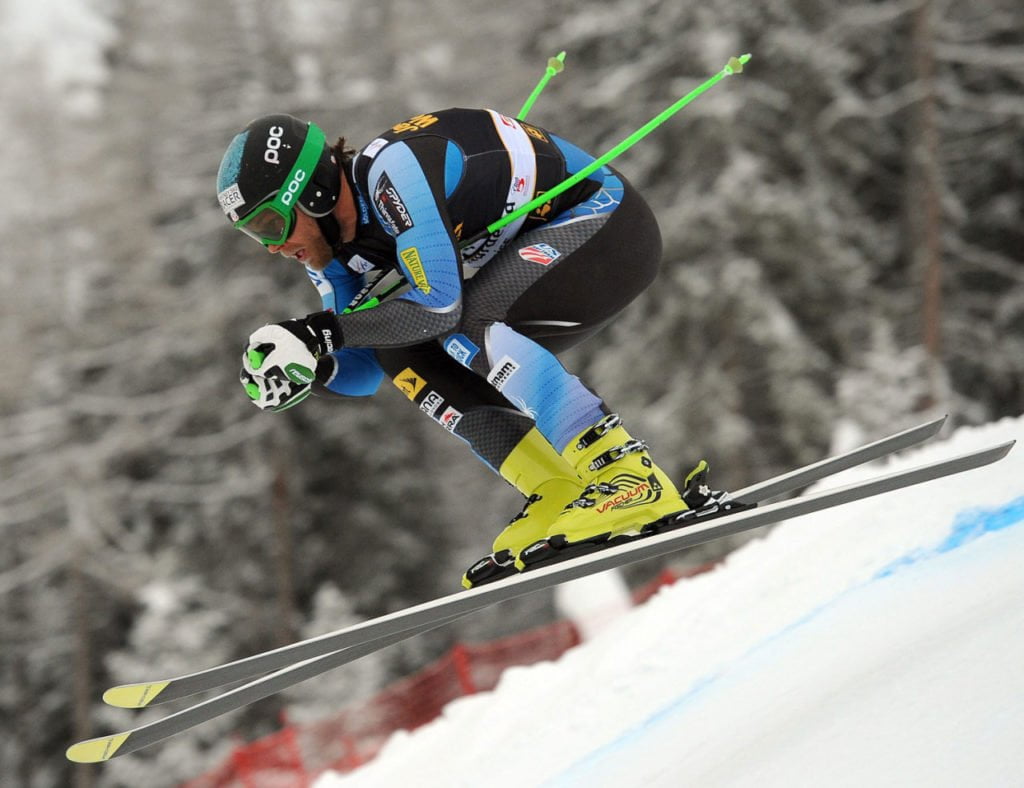
Like the athletes who compete on ice, skiers rely on a film of liquid beneath their skis to provide the low friction necessary to glide. The moisture results from the friction of the ski’s base and edges cutting into the snow, and, depending on the conditions of the snow, different surface treatments are recommended for the skis to help control and direct this lubricating film. Similarly, skiers uses various waxes on their skis to lower surface tension and provide additional lubrication. Fluid dynamics can also play a role in tactics for various ski-based events. In endurance events like cross-country skiing, drafting behind other skiers can help an athlete avoid drag and save energy. When drafting, cross-country skiers have lower heart rates. Drag and aerodynamics can also play a significant roles in alpine skiing, especially in speed events like the downhill or super G. In these events solo skiers reach speeds of 125 kph, where drag is a major factor in slowing their descent. Between turns smart skiers will tuck, decreasing their frontal area and reducing drag’s effects. Athletes use wind tunnel testing to dial in their tuck position for maximum effect, and, like speedskaters, skiers may also wear special aerodynamic suits. (Photo credits: F. Cofferini/AFP/Getty Images, C. Onerati; h/t to @YvesDubief)

London 2012: Swimming Pool Physics
The era of the LZR suit may be over in swimming, but technology is still making an impact when it comes to making swimmers faster. One thing you’ll often hear from commentators is how the London Aquatic Center boasts one of the world’s fastest pools. When swimmers compete, they have to contend with all the turbulence created in the pool by eight people trying to direct as much water behind them as possible as quickly as possible. Like ripples spreading on a pond, these waves travel, reflect, and interfere, ultimately disrupting the swimmers and causing extra drag. In a fast pool, engineers have made adjustments to reduce the impact of these waves on swimmers. Firstly, the pool is 3 meters deep, meaning that vertical disruptions are mostly damped out before they reach the bottom, so any wave reflected off the bottom of the pool will be extremely weak. Along the sides and ends of the pool, a special trough captures surface waves, preventing them from reflecting back out into the pool. The lane lines are also designed to soak up wave energy so that it does not propagate as much between lanes. When waves hit the lines, their links spin, dissipating some of the wave’s energy.
Despite these advances, the outermost lanes–those against the walls–are not used in competition. This helps to equalize the turbulence between lanes. Whether there is any fluid mechanical advantage to being in a particular lane is debatable. The outer lanes have the advantage of only one competitor’s wake to contend with, but they isolate the swimmer so he or she cannot see their competition as well. In the inner lanes, you’ll sometimes see swimmers try to swim close to the lane line if their competition is ahead of them, the idea being that they may be able to draft on their competitor’s bow wave to reduce drag. Generally speaking, the lane positions are determined by seeding going into the event, where the faster swimmers are given the innermost lanes. This is why it’s rare to see gold medals coming from the outermost lanes. For more, check out NBC’s video on designing fast pools (US only, unfortunately). (Photo credits: Associated Press, Reuters, Geoff Caddick)

Flow Around Traffic
Flow visualization in a water tunnel shows what the flow around a line of traffic looks like. Note the progressively more turbulent flow around each car as it sits in the wake of the car before it. Turbulent flow is usually associated with increased drag forces, but because turbulence can actually help prevent flow separation it is sometimes desirable as a method for decreasing drag. In the case of these cars drafting on one another, it is clear that the cars further back in the line cause less effect on the fluid–and thus have less drag to overcome–than the front car. (Photo credit: Rob Bulmahn)

Vertical Axis Wind Turbines
Conventional wind turbines feature horizontal axis propellers which must be placed far apart from one another to avoid wake interference. Researchers have found that using vertical axis wind turbines specially arranged to utilize the wake of one turbine to improve the efficiency of its neighbor can produce far more energy per square meter of land. The inspiration for this arrangement came from fish, which also derive benefits from the drafting that occurs in their schools. #
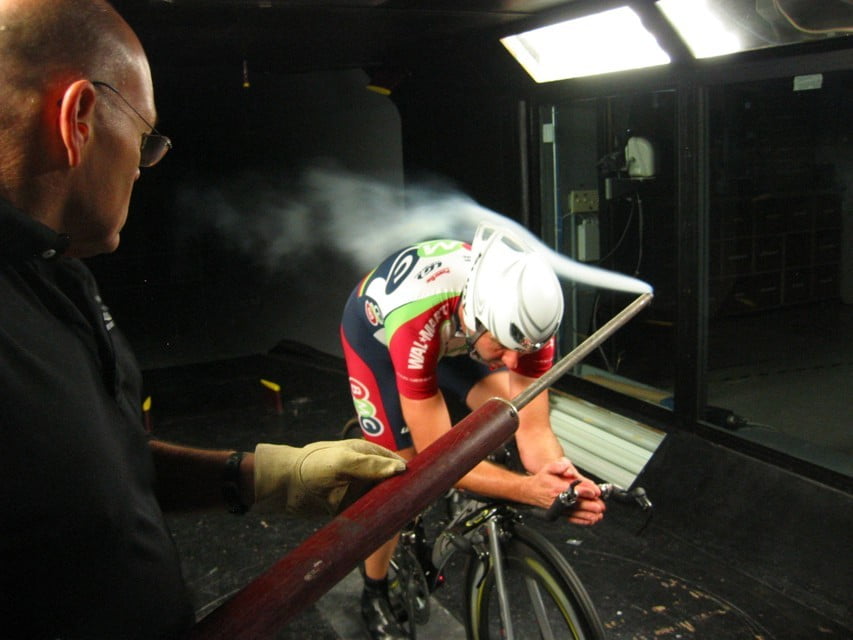
Tour de France Physics: Wind Tunnel Testing
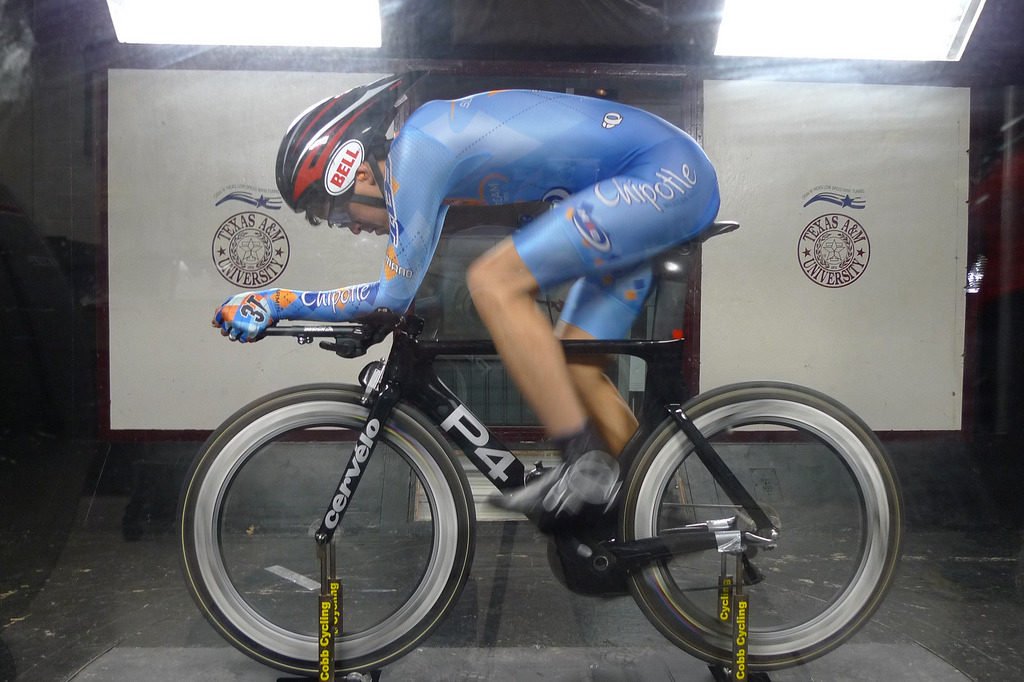
Over hours of racing, even a few grams of drag can be the difference between the top of the podium and missing out. For manufacturers as well as for individual professional cyclists, hours of wind tunnel testing help determine optimum configurations of equipment and positioning. During a day of wind tunnel testing, a cyclist may complete dozens of runs, in which bikes, wheels, helmets, skinsuits, and positioning are all tested and tweaked to find the best combination of aerodynamics.
But wind tunnel results don’t always translate perfectly to the road, where buildings, people, cars and other cyclists may interfere with the freestream. And, as any cyclist will attest, the wind is constantly shifting and changing speeds as one rides. The Garmin-Cervelo pro team has developed a rig to measure wind speeds and angles experienced by cyclists in real world conditions. (The exact components used are unclear, but probably include some form of Pitot tube or 5-hole probe.) As more on-the-road data is collected, wind tunnel tests can be improved by placing greater emphasis on the most common wind angle conditions. (Photo credits: John Cobb, Flo Cycling, and Nico T)
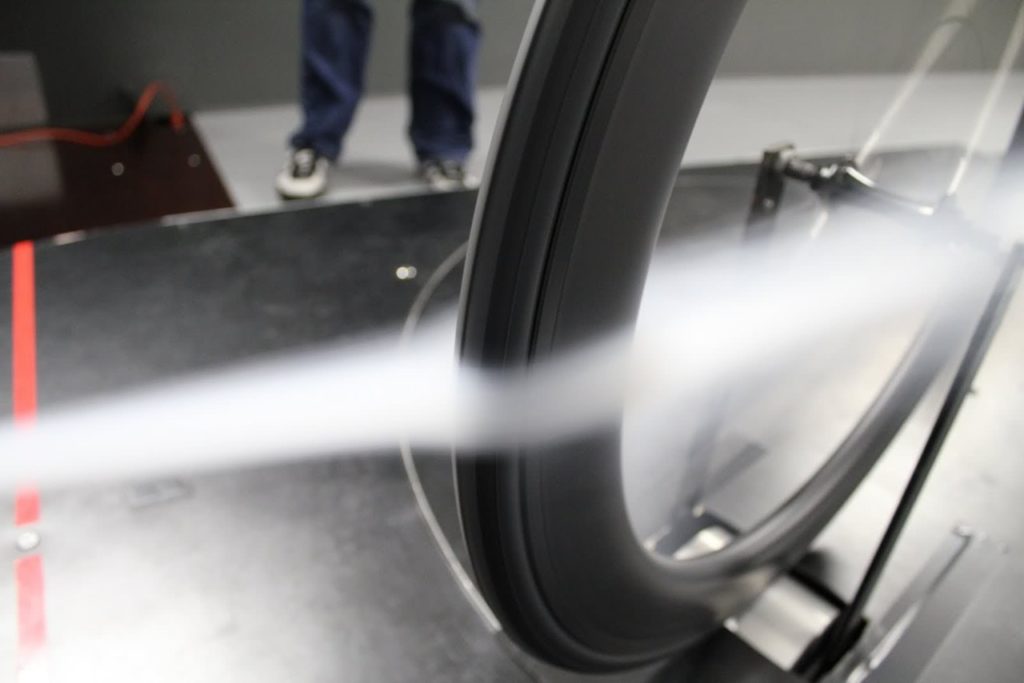
This completes FYFD’s weeklong celebration of the Tour de France and the fluid dynamics of cycling. See previous posts on drafting in the peloton, pacelining and echelons, the art of the sprint lead-out train, and the aerodynamics of time-trialing.
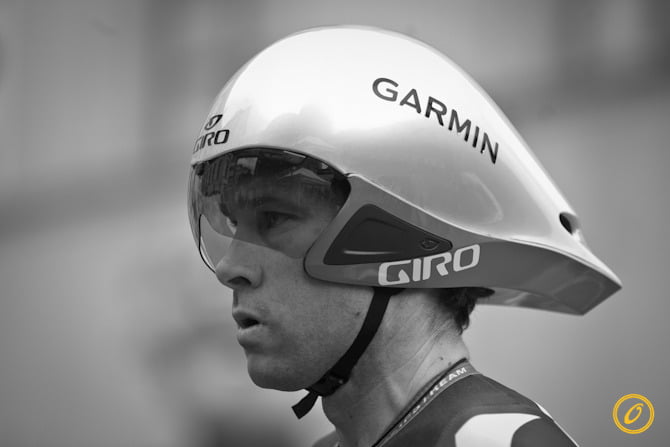
Tour de France Physics: Time Trials
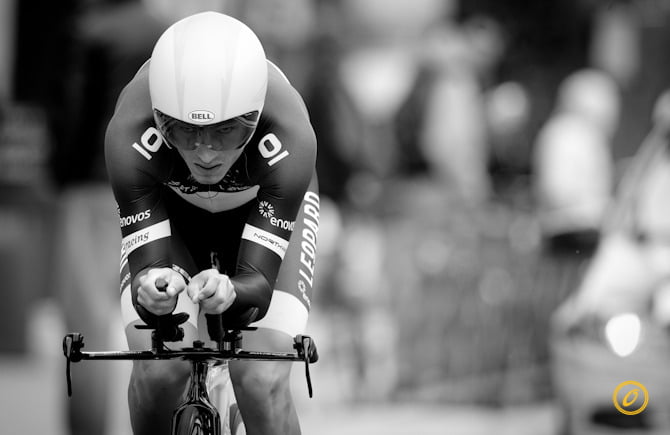
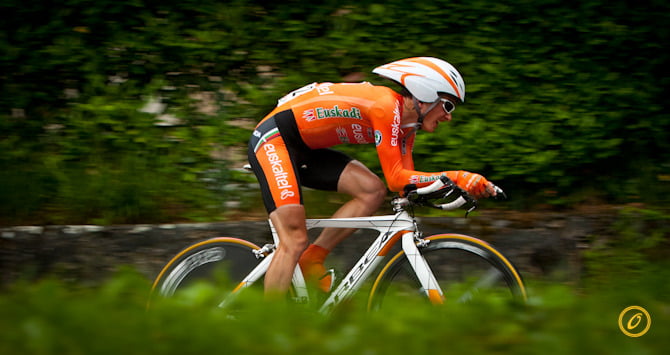

Unlike road stages in which cyclists can draft off one another to reduce drag, in the time trial a cyclist is on a solo race against the clock with nowhere to hide. As a result, the event features lots of technologies designed to reduce both pressure drag and skin friction on the cyclist. For time trials, cyclists wear skinsuits and shoe covers to eliminate any sources of flapping fabrics and to reduce skin friction. They ride bicycles designed to be as light and aerodynamic as possible. Instead of rounded tubing in the frames, these bikes consist of elongated airfoil profiles that direct air past and prevent separation that may increase pressure drag. The rims of their tires are wider and the back wheel is replaced with a disc wheel that allows no airflow aross the wheel. Like the airfoil tubing, these changes help prevent separation. Similarly, riders wear elongated helmets designed to be as aerodynamic as possible while the rider is in the “aero” position, with arms directed out over the wheels, head level, elbows tucked, and back flat. In wind tunnel tests, the rider best able to hold this position will experience the least drag. Even the addition or subtraction of a water bottle is not left to chance, with many time trial bikes designed to be more aerodynamic with a water bottle onboard (though you probably won’t catch the cyclists breaking their aero position to get a drink)! (Photos by Veeral Patel)
FYFD is celebrating the Tour de France with a weeklong exploration of the fluid dynamics of cycling. See previous posts on drafting in the peloton, and pacelining and echelons, and the art of the lead-out train.
Tour de France Physics: Lead-Out Trains
[original media no longer available]
One of the most impressive cycling techniques for drag reduction on a rider is the lead-out train that delivers a sprinter to the finish line. No current team is better at this than HTC-Highroad. Watch for them in the white and yellow from about ~4:00 in the above video.
The lead-out train begins 5 km or so before the line, with the entire team in a line at the front of the peloton with the sprinter in the final position. The rider at the front will ride for as long and hard as he can, ensuring that the pace is such that no riders from the main field are able to pull ahead. This accelerates the sprinter to higher speeds while sheltering him in the wake of the rest of the team.
One by one, the riders of the team will do their time at the front, expending their energy while protecting the sprinter. The final lead-out rider will be sprinting a few hundred meters from the finishing line; at this point the sprinter in the back may be riding 70 kph while enjoying protection from the wind. Finally, with the finish line in sight, he will swing out around his lead-out man and go all out for the line. Sprinters can hit speeds of nearly 80 kph in these short bursts.
FYFD is celebrating the Tour de France with a weeklong exploration of the fluid dynamics of cycling. See previous posts on drafting in the peloton, and pacelining and echelons.

Tour de France Physics: Breakaways
In cycling, a small group of riders often leave the protection of the peloton in a breakaway. These riders will often spend 80% or more of a stage or race outside of the peloton, trying to reach the finish line before they’re caught. Because the pressure drag is so draining on a lone cyclist, it’s vital that breakaway riders work together. When the wind comes predominantly from the front or back, riders will form one or two lines, riding with their wheels within a foot of one another (see ~0:23). This paceline rotates so that every rider takes a turn at the front, bearing the brunt of the effort while other cyclists recover in their wake, where they experience less drag.
If the wind blows predominantly across the riders, they will form a diagonal line with the frontmost rider rotating behind for shelter from the wind after a pull. This drag reduction technique is called an echelon (see ~1:40). As seen above, for experienced riders the echelon can protect individuals even in bike-stealingly high winds.
FYFD is celebrating the Tour de France with a weeklong exploration of the fluid dynamics of cycling. See part one on drafting in the peloton.





